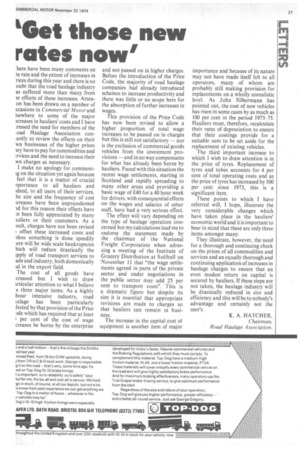'Get those new rates now'
Page 29

If you've noticed an error in this article please click here to report it so we can fix it.
'here have been many comments on ie rate and the extent of increases in rices during this year and there is no oubt that the road haulage industry as suffered more than many from le effects of these increases. Attenon has been drawn on a number of ccasions in Commercial Motor and lsewhere to some of the major 'creases in hauliers' costs and I have :ressed the need for members of the mad Haulage Association conantly to review the effects on their wn businesses of the higher prices ley have to pay for commodities and :rvices and the need to increase their wn charges as necessary.
I make no apology for commentig on the situation yet again because feel that it is a matter of crucial nportance to all hauliers and [deed, to all users of their services. he size and the frequency of cost [creases have been unprecedented -id for this reason their effects have 3t been fully appreciated by many tuliers or their customers. As a 'suit, charges have not been revised I offset these increased costs and iless something is done speedily [ere will be wide scale bankruptcies hich will reduce drastically the ipply of road transport services to ade and industry, both domestically id in the export field.
The cost of all goods have creased but I wish to draw irticular attention to what I believe e three major items. As a highly bour intensive industry, road tulage has been particularly fected by that provision of the Price )de which has required that at least 1 per cent of the cost of wage creases be borne by the enterprise and not passed on in higher charges. Before the introduction of the Price Code, the majority of road haulage companies had already introduced schemes to increase productivity and there was little or no scope here for the absorption of further increases in wages.
This provision of the Price Code has now been revised to allow a higher proportion of total wage increases to be passed on in charges but this is still not satisfactory — nor is the exclusion of commercial goods vehicles from the investment provisions — and in no way compensates for what has already been borne by hauliers. Faced with this situation the recent wage settlements, starting in Scotland and rapidly spreading to many other areas and providing a basic wage of £40 for a 40 hour week for drivers, with consequential effects on the wages and salaries of other staff, have had a very serious effect.
The effect will vary depending on the type of haulage operation concerned but my calculations lead me to endorse the statement made by the chairman of the National Freight Corporation when adressing a meeting of the Institute of Grocery Distribution at Solihull on • November 11 that "the wage settlements agreed in parts of the private sector and under negotiations in the public sector may add 25 per cent to transport costs". This is a dramatic figure but despite its size it is essential that appropriate revisions are made to charges so that hauliers can remain in business.
The increase in the capital cost of equipment is another item of major importance and because of its nature may not have made itself felt to all operators, many of whom are probably still making provision for replacements on a wholly unrealistic level. As John Silbermann has pointed out, the cost of new vehicles has risen in some cases by as much as 100 per cent in the period 1973-75. Hauliers must, therefore, recalculate their rates of depreciation to ensure that their costings provide for a suitable sum to be set aside for the replacement of existing vehicles.
The third important increase to which I wish to draw attention is in the price of tyres. Replacement of tyres and tubes accounts for 4 per cent of total operating costs and as the price of tyres has increased by 100 per cent since 1973, this is a significant item.
These points to which I have referred will, 1 hope, illustrate the very considerable changes which have taken place in the hauliers' economic world and it,is important to bear in mind that these are only three items amongst many.
They illustrate, however, the need for a thorough and continuing check on the prices of all commodities and services and an equally thorough and continuing application of increases in haulage charges to ensure that an even modest return on capital is secured by hauliers. If these steps are not taken, the haulage industry will be drastically reduced in size and efficiency and this will be to nobody's advantage and certainly not the user's.
K. A. HATCHER, Chairman, Road Haulage Association.




















































































































